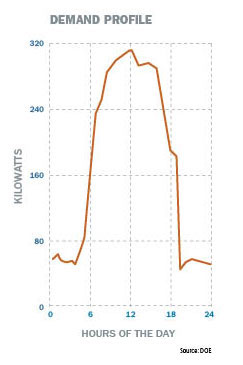Managing the peak
 Smart-grid technologies also are expected to help utilities deal with one of their biggest challenges: peak energy usage. When electricity demand outstrips supply, failures occur on the grid, resulting in lost revenue for the utility and customers angered by the inconvenience or the loss of business opportunities (see “The Dark Side: Average Cost for 1 Hour of Power Interruption” table at the end of this story).
Smart-grid technologies also are expected to help utilities deal with one of their biggest challenges: peak energy usage. When electricity demand outstrips supply, failures occur on the grid, resulting in lost revenue for the utility and customers angered by the inconvenience or the loss of business opportunities (see “The Dark Side: Average Cost for 1 Hour of Power Interruption” table at the end of this story).
While utilities try to generate enough power to address peak loads, the task is complicated by the fact that building new generation plants is extremely expensive — and virtually impossible in some areas of the country, for political reasons. As a result, using existing power more efficiently and integrating renewable energies from solar-energy and wind-energy farms is critical.
“The promise of smart grid is that it will allow the entire network to communicate with itself and enable some things they just can’t do right now,” said Scott Propp, Motorola’s senior director of engineering and technology for wireless network solutions. “Currently, [utilities] generate about twice as much power as they need, because they have to be ready for the peak demands in the system, and they have no way to moderate the demand of the customer without any kind of communication system.”
The smart grid not only will reduce the need to stockpile capacity that may not be needed, it also will help utilities avoid the need to purchase capacity at inflated market prices when supplies run short, according to experts, perhaps by letting them time-sync air-conditioning loads during peak periods, such as mid-afternoon on a scorching summer day.
For instance, instead of shutting off power completely in a blackout/brownout scenario, utilities with smart-grid capabilities could manage the usage load during such circumstances — perhaps raising all of the thermostats in the affected area by a degree to ensure that essential power can be provided.
One significant new variable in the electric-demand equation is the popularity of hybrid and electric automobiles, which can double a household’s electric consumption when they are charged on the fastest settings. With smart-grid capabilities, a utility could stagger the charging of such vehicles in a neighborhood; otherwise, a transformer could fail under the strain of multiple cars in a neighborhood charging simultaneously.
“They create new demands on the system that aren’t necessarily well planned for,” Propp said. “If somebody buys a new Volt in southern California and plugs it in, they create a massive new demand on the feeder line — and, without instrumentation, these [utilities] wouldn’t even know the demand existed.”
In addition, customers could use the smart-grid capabilities to lower their energy bills by adjusting their usage remotely when away from home or work. And “smart” appliances that could be on the market as early as next year are expected to help consumers make better energy choices at home, said Klaus Bender, director of standards and engineering for the United Telecom Council (UTC).
“The vision is that the meter communicates with the home energy-management device, transmitting billing information and electricity rates, so that the home energy-management system can alert the consumer — ‘Hey, you’re on peak power now; you don’t necessarily want to be doing that load of laundry,’ — to the point of facilitating the control of various electric components remotely,” Bender said.










